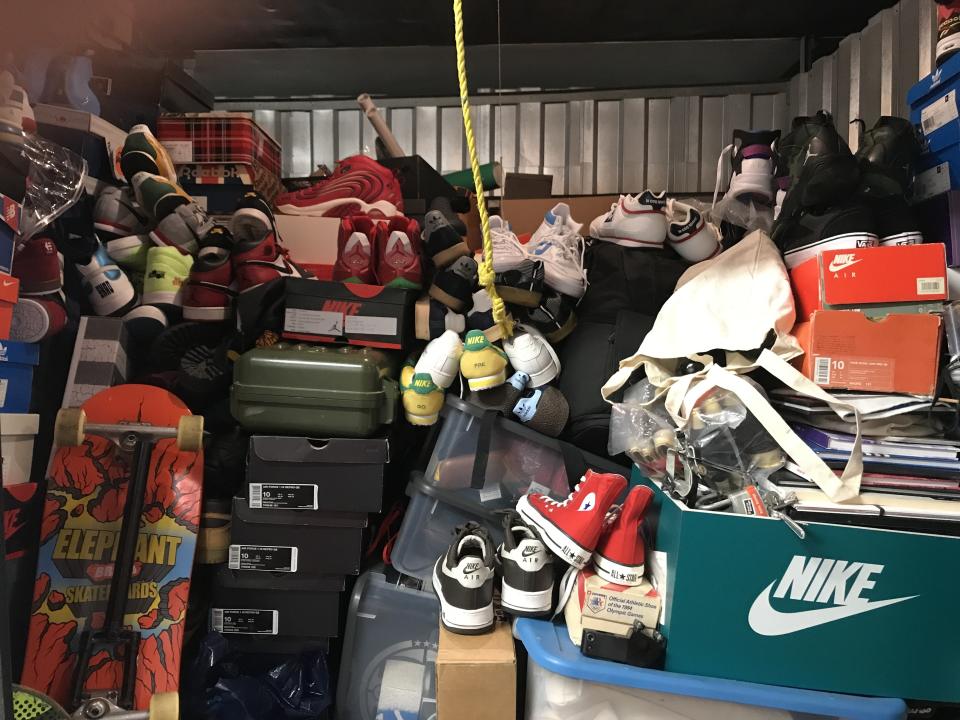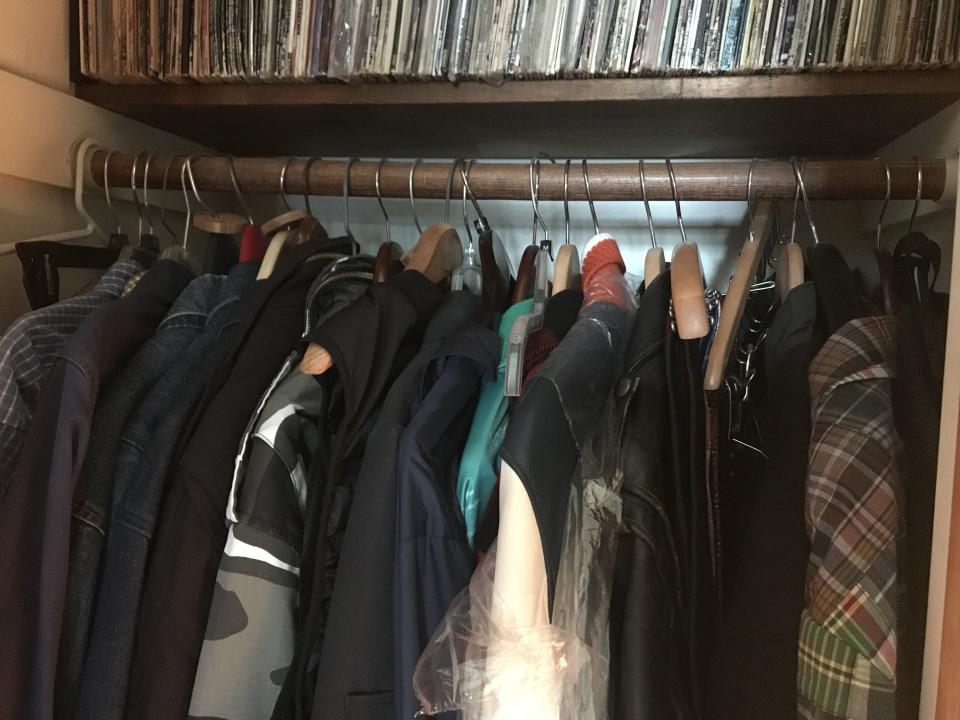The Life-Changing Magic of Emptying Your Enormous Storage Unit Full of Sneakers
In the end, it was the jackets that did it. In a recent apartment shake-up, I took most of my jackets out of the one closet my girlfriend and I share and hung them from an industrial pipe rack she had previously built along one wall of the bedroom, swapping them in for the button-down shirts that had hung there since I moved in. The button-downs took up less closet space, the jackets were more accessible for the fall. Win-win.
But all of my jackets didn’t fit on the rack. And that’s just the ones that were in the apartment. My childhood bedroom closet at my parents’ house held more. To start: both the black and winter camo versions of the Slayer x Supreme M65, a vintage Schott Perfecto, an SNS x Vanson leather still in the plastic, a buffalo-plaid Filson mac I scored at a Delaware thrift back in the early ‘90s. Then there were the bins, plural, in the attic—not to mention the entirely separate bin of hoodies. We won’t even get into the jerseys and concert tees and fitteds. I’d been collecting something or another since before Marie Kondo was born—and even after everyone started talking about going minimal, I was still going for the max.
Accumulation has always come easy to me, and I’ve been doing it for literally decades now. I’ve had practice. If I liked something enough and I had a place to put it, I bought it. And if I saw something that I felt was too cheap to leave there, I...didn’t leave it there.
Work didn’t make things easier. The stuff expanded exponentially when I received my very first pair of seeded sneakers—black and gold Reebok Questions—as a SLAM editor back in 1996. That trickle eventually became a flood, filling offices and apartments alike. I was at SLAM for nearly a decade and later joined Complex as their first-ever sneaker editor. And all the while the tap stayed on. I probably averaged a couple pairs of sneakers a week for 20 years straight—and that’s not even getting into peripheral items like T-shirts and hoodies. Somewhere along the way I transitioned from collector to archivist. There was no way I could possibly find room for all of this stuff, although I certainly tried. And I even had the luxury of overflow! My parents have lived in the same house since I was a kid, and I still have the 10x10 storage unit I rented when I moved out of a no-longer-remotely-affordable midtown apartment.
This is not to say I’ve never sold or given anything away, because I’ve done plenty of both. But that’s just been a matter of dealing with the symptoms rather than seeking a cure. Skimming off the top. Listing a bunch of stuff on eBay or taking a couple of duffel bags full of stuff to Goodwill or Buffalo Exchange always makes me feel better. For a while. My habits haven’t changed—I’m still scouring thrift stores and cruising the clearance racks at Marshall’s and Macy’s. So the space inevitably fills up again, in the same way a hole on the beach is filled by an incoming wave.


But lately, I’m realizing that the justification I had for buying new stuff, or keeping old stuff around—“Well, I might wear/need this someday”—just doesn’t hold up anymore. It seemed like a reasonable consideration when I was in my late 20s, less of one when I was in my late 30s, and a downright ridiculous one now that I’m in my late 40s. If I haven’t gotten to it by now, will I ever? Recently, in a totally different context, a therapist suggested I ask myself “If not now, when?” They might as well have been talking about my closet.
At this point, I'm realizing that what I really need to do is start unloading stuff, even if I technically have room for it. (I don’t.) I’m thinking of it this way: I’ve spent the previous three decades or so accumulating raw material. Now it’s time to sculpt.
The difficult part is: Letting go of things go that I wore (or bought thinking I'd wear) is like letting go of the person I was (or at least thought I'd be). The reduction process is less about getting rid of articles of clothing than accepting that certain stages of my life are over—or maybe that they never happened at all. It’s a series of sunk costs—with a psychological cherry on top. If you think that buying something opens a door, it follows that selling it (or giving it away) closes it. No wonder the latter is harder. If Fugazi was wrong and I am what I own, what happens to me when I start trying to own less?
So far I’ve mostly worked the problem around the edges. I still have far too many jackets, far too many t-shirts, a downright obscene number of sneakers. So I’ve started unloading other things, from unread books to unridden bikes—and I’ve discovered that sometimes closing those doors can actually feel good. Selling the orange LeMond cyclocross bike that had hung in my parents’ garage for a decade wasn’t something I necessarily wanted to do—but all it was doing for me was taking up space, and the guy I sold it to was excited to ride it. Getting rid of that bike eliminated the silent rebuke that met my eyes every time I went in that garage. It was undoubtedly for the best.
And so I head into this autumn eyes wide open, perfectly aware that the whole point of an “everyday” article of clothing is that one does not need to own a dozen different varieties of it. Those three pairs of Tellason mid-rise selvage denim jeans (two of them unworn!) need to go. A whole bag of old concert tees needs to be taken to Metropolis. And I will likely never be a Reebok Pump Fury person no matter how cool I think the design is. I am making progress. I will make more. But at the same time, old habits die hard. The other day, flipping through the racks at Savers, I came across a plaid, US-made, Gitman Bros. button-down for $3.99. For that price? I couldn’t leave it there.
Originally Appeared on GQ

